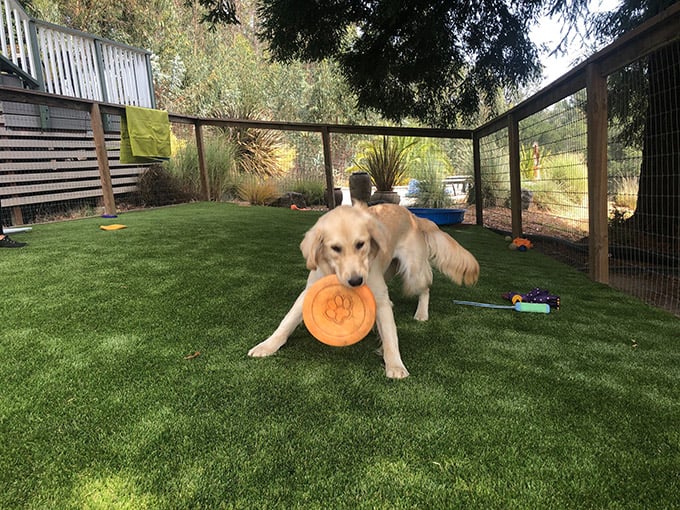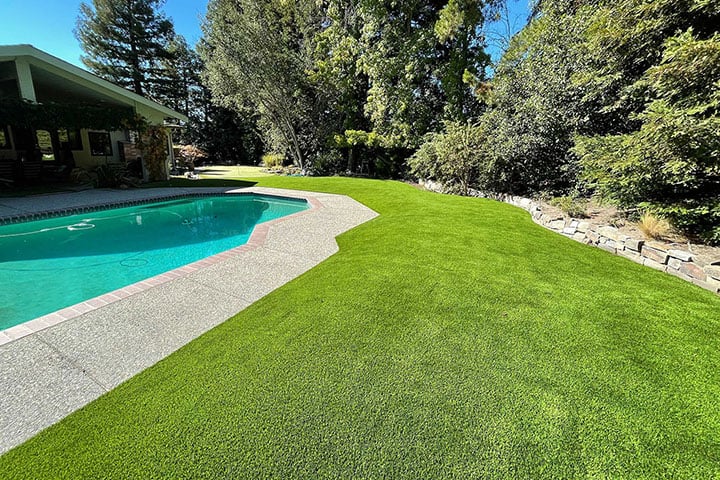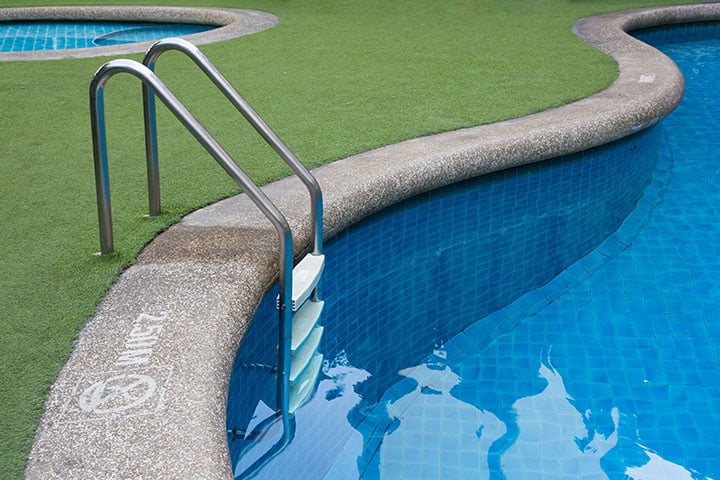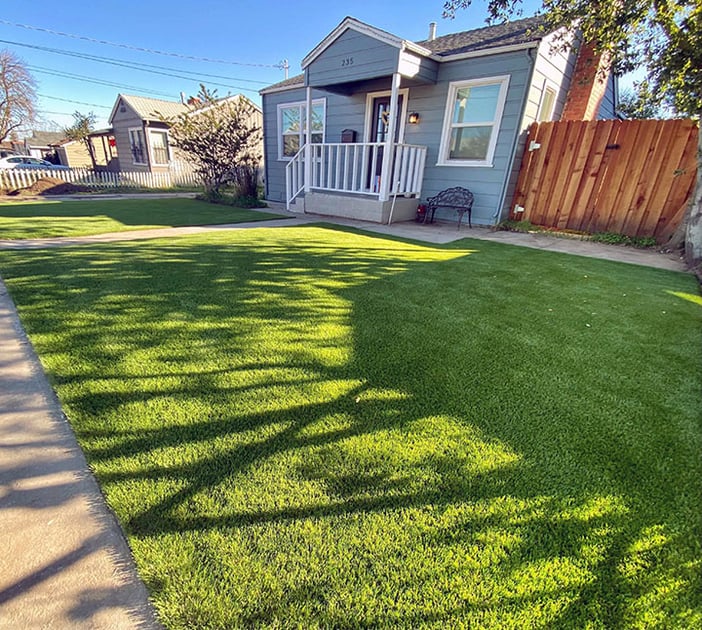Outdoor Turf for Dogs: Top 15 FAQs for Pet Owners

Dogs are family and naturally, we want only the best for them. That includes the surfaces they play on. Unfortunately, not every surface is conducive to your dog’s health and well-being. Real grass, for instance, harbors insects, toxins, pollen, poisonous weeds and other elements that can be harmful to your dog.
For that reason, many dog owners are more than happy to replace real grass with outdoor turf for dogs.
Interested in making the same investment for your furry friend? We understand that you want to make sure you're making the best decision for your dog. That's why we've gathered some of the most common questions we get about pet turf and answered them in detail below!
1. Is real grass or artificial grass better for dogs?
In several ways, artificial turf is better for dogs than natural grass. For instance, you do not have to worry about your dog digging up the yard and leaving a mess. You also do not have to worry about your dog eating the grass.
Artificial grass is generally safer for dogs, too. For example, your dog could get sick if they eat grass that has been treated with fertilizers and pesticides or by simply getting exposed to these substances. Since artificial turf doesn't need any of those chemicals, it is safer for your dog.
Synthetic turf can also reduce the risk of skin problems and infections for dogs that are prone to allergies or other sensitivities. Flea and tick infestations are also less likely to occur with artificial turf because it doesn't offer shelter or nutrients to pests.
Furthermore, there is less risk of your dog getting injured when they are running around on artificial grass compared with natural turf. This is because synthetic lawns do not have any rocks, sticks, burrs or bugs to step on or get tangled up in.
2. Can dogs poop on artificial grass?
Absolutely. They can go potty on synthetic grass the same way they do on a natural lawn. The only difference? It's MUCH EASIER to clean pet waste off artificial grass.
Specifically, pick up any solid waste and throw it away. If there are any residues, rinse them away with water. You can also use a mild soap solution to clean the area more thoroughly.
3. What happens if a dog urinates on artificial grass?
It's actually better for the dog to urinate on artificial grass than real grass. The urine will not affect the material in any way and it won't leave a puddle that could breed all sorts of bacteria or mold.
As for the urine itself, simply let synthetic turf's drainage backing take care of it. We do recommend keeping your sprinklers intact and regularly rinsing down your dog's potty spots to keep odor under control.
4. Can my dog be allergic to artificial grass?
Unless your dog is allergic to polyethylene or nylon, then no. In fact, artificial grass can actually help dogs with grass allergies because it does not produce pollen, which is one of the most common allergy triggers for both pets and humans.
5. Will my dog like artificial grass?
We're 100% confident that your pet is going to love it! Dogs can't tell the difference between real grass and synthetic grass. All they know is that synthetic turf feels soft and wonderful on their paws. Perfect for playing fetch, running around or just napping in the sun!
On top of that, your dog will probably notice that their favorite human (aka you) now has more time to play and hang out with them, since you won't have to waste time mowing, watering or weeding anymore. Add the fact that they won't need so many baths (since there's no mud or dirt on a synthetic lawn) and your synthetic yard will soon be their favorite part of the house!
6. What goes under outdoor turf for dogs?
A high-quality pet turf system is usually made of several components:
- The sub-base: this is a layer of compacted stone or recycled rubber that acts as the foundation for artificial grass and keeps it stable.
- The drainage layer: this is a mesh or grid with lots of holes that allow water to drain away. It's essential for pet turf!
- The weed membrane: this is a fabric layer that prevents weeds from growing through your pet turf.
- The infill: Infill is what gives artificial grass its nice, soft feel. For best results, we recommend using an infill designed especially for pet turf, since it neutralizes odor and also comes with anti-microbial properties.
- The turf: this is what you see when looking at artificial grass for dogs!
These components are usually installed in layers on top of each other to make up one complete system.
7. How long does artificial turf for dogs last?
The highest quality synthetic grass can last anywhere from 10 to 20 years, which means you won’t need to replace it anytime soon!
8. Can dogs damage artificial grass?
No, dogs can't damage artificial grass. The polyethylene blades of grass are designed to withstand heavy use, so they won't wear down or be deformed by dogs running, jumping and playing on it. They can't dig through the material, either.
9. How do you maintain synthetic grass for dogs?
Maintaining pet grass requires a lot less effort than real grass because you won't have to water it, mow it or fertilize it. All you have to do is sweep off the leaves and debris, then give it a good rinse from time to time.
10. Is pet artificial grass for dogs expensive?
It requires a higher upfront investment than real grass, but it quickly pays for itself. For one, you get to save a significant amount of money on water and other yard maintenance costs.
To make the installation more affordable, we also offer different financing plans, some with no interest included!
11. How much does artificial grass for dogs cost?
It really depends on the specifics of your project. Some factors that might affect the price include:
- Size/dimensions of the yard
- Volume of material required for installation
- Complexity of design
- What type of artificial grass products you're looking to get, including other elements like infill
- How much work needs to be done (removing old turf, digging up dirt, etc.)
Beware of contractors who will give you a set price for the project, regardless of the work it involves. A high-quality installation should be customized for your needs, which means that it should be priced accordingly.
12. Does pet turf get muddy?
No, artificial grass for dogs will never get muddy no matter how wet it gets, so say goodbye to those dirty paws and paw prints around the house!
13. Does pet turf smell bad?
Synthetic grass for dogs is odorless. If any smells do occur, they're usually caused by urine or feces left on the artificial lawn longer than necessary. Once your pet goes potty on the lawn you should clean it up as soon as you can.
14. What is artificial grass for dogs made of?
Artificial dog grass is made of nylon or polypropylene. These materials are completely safe for pets. They are also non-toxic and lead-free.
Here’s a more in-depth look at how artificial grass is made, as well as a bit of history on turf!
15. Where can I learn more about artificial grass for dogs?
The Heavenly Greens blog is filled with helpful articles about pet turf! Here are some articles to get you started:
Let’s Get Started!
No matter where you’re at with this decision, we’re right there with you! We’d be happy to answer all your questions about synthetic grass, as well as help you explore your options. Please call us at 844-287-5876 or send us a message here to begin.
Meanwhile, check out some of our past pet turf installations to see Heavenly Greens artificial grass in action! You can also read reviews of our services here, several of which come from real pet owners who are now enjoying synthetic grass.











